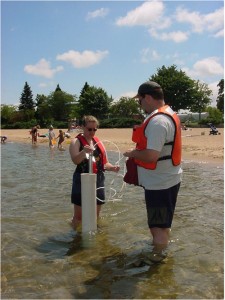By Rachael Gleason
rachaelkaygleason@gmail.com
Great Lakes Echo
Oct. 6, 2009
Editors note: This is part of a series relevant to the International Joint commission’s biennial meeting in Windsor on Wednesday and Thursday.

United States Geological Survey scientists sample bacteria at Clinch Beach in Traverse City, Mich. Photo: U.S. Environmental Protection Agency.
More than 20,000 beaches closed last year when water samples tested positive for harmful bacteria.
But inconsistent sampling methods have Great Lakes officials questioning those results.
The International Joint Commission, a binational organization that advises the U.S. and Canada on Great Lakes issues, examined problems with beach testing methods and advisory systems in a report released last month.
It is among the issues to be discussed at the commission’s biennial meeting Wednesday and Thursday in Windsor.
And it’s a good time to do so, according to Julie Kinzelman, a research scientist for the Racine Health Department in Wisconsin and board member of the Great Lakes Beach Association.
“The United States and Canadian Water Quality Agreement is under revision, so this is the appropriate time to develop water quality criteria and test methods,” she said.
Officials test beach water for Escherichia coli, which can cause human sickness, but is used primarily as an indicator of sewage and other pollution problems, according to the commission report.
In both countries, the national environmental agencies set the guidelines for testing the water, but it’s up to the local governments to do the testing.
Still, the commission report shows testing methods may not accurately reflect the amount of bacteria in the water. Samples are highly variable to factors such as depth, time of day, replication, frequency and laboratory procedures.
DEPTH
Samples taken from shallow water typically have higher concentrations of E. coli.
“The depth makes a tremendous difference,” said Gregory T. Kleinheinz, a beach coordinator for the Wisconsin Department of Natural Resources. “In Wisconsin, everyone has to do it at the same depth.”
That depth is knee-deep about a foot below the surface of the water, according to the Natural Resources Defense Council, an international environmental advocacy group.
But in Illinois, samples are taken in waist-deep water, which typically has lower concentrations of bacteria.
TIME OF DAY
Levels of bacteria change throughout the day, so samples taken in the morning are higher than when the sun sets.
“If there’s a strong breeze and more wave action on a sunny day, the E. coli will be killed off during the day,” Alley said.
Most of the states included in this year’s Testing the Waters report by the defense council claimed to test water in the morning, but not all follow this guideline diligently.
“We encourage people to collect them during the time when people are swimming,” said Kleinheinz, who is also a professor of microbiology at the University of Wisconsin-Oshkosh.
REPLICATION
Several samples within the same beach are needed to accurately reflect the amount of bacteria, which tend to move around water, according to the commission report.
Some states only take one sample per beach while other require the average of three samples to determine a beach advisory. That’s how Pennsylvania and Minnesota do it, but not all states report how many samples they take.
FREQUENCY
Only 1 percent of 922 beaches in Michigan, which has more than 500 miles of coastline around three of the Great Lakes, were tested more than once a week last year, according to the defense council report. More than 70 percent of beaches were not monitored at all.
Pennsylvania officials tested water samples more than once a week at almost all of its beaches last year, but the state has the least amount of coast.
“Most places would like to be monitoring every day. The problem is until the funding comes through to allow people to do that,” Kleinheinz said.
Most beaches are controlled by several state health and environmental agencies and receive funds from the federal government. The Beach Act in the United States appropriates funds to local agencies.
LABORATORY PROCEDURES
The commission also found that laboratories sometimes came up with varying results due to different levels of equipment and analysis techniques.
“The equipment is very expensive and sometimes smaller communities can’t afford that,” Alley said.
OTHER PROBLEMS
The time it takes to receive sampling results – approximately 18 to 24 hours – is also problematic, Kinzelman said.
“We’re taking regulatory action based on a previous day’s sample. From a public health perspective, rapid tests are necessary,” she said.
States like Ohio are testing models that predict E. coli levels based on variables like wind, wave-length and rainfall.
Such a system, called Nowcast, supplied a correct prediction 85 percent of the time at one Lake Erie beach and 61 percent of the time at another, according to the company’s Web site.
“There are some jurisdictions that have gone strictly to that method,” Alley said. “It’s much more reliable than testing.”
Keep up the good work! Look forward to reading more from you in the future. I think it will be also nice if you add “send to email” tool so people can forward the articles to their friends easily.
Pingback: International Joint Commission examines Great Lakes water quality | Great Lakes Echo